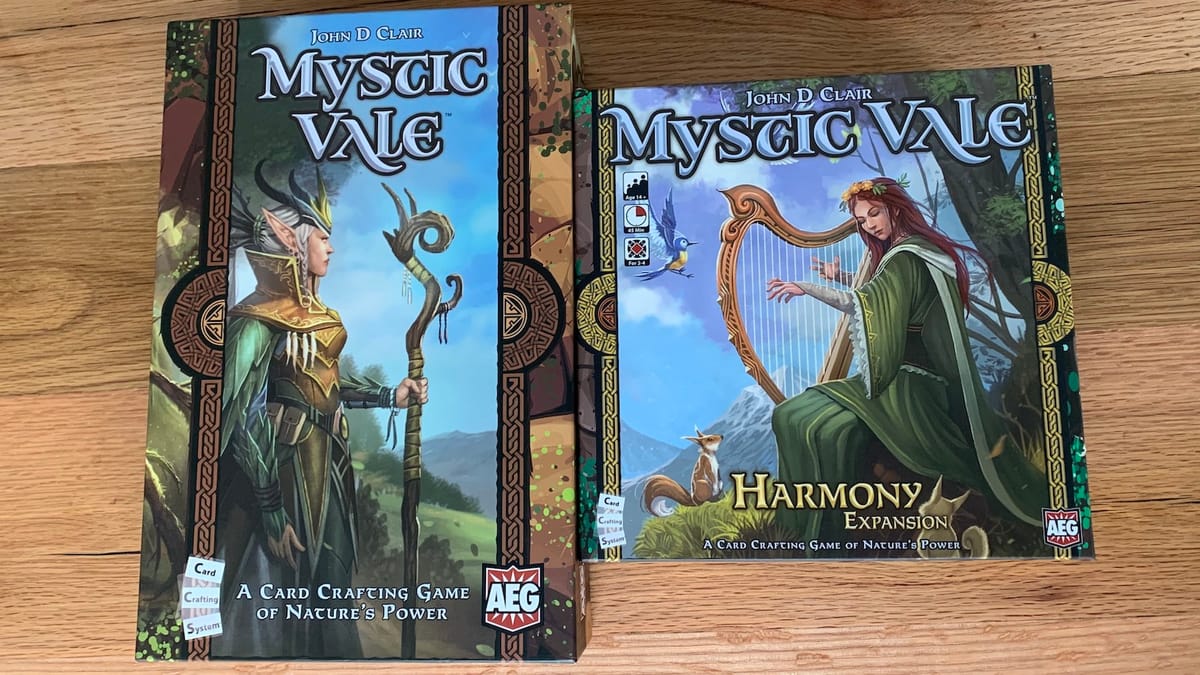
As a druid the wilderness is your home, and when a threat presents itself to your land, you do all you can to restore it to its former glory. You must bond with nature and build your strength with it in order to bring peace and harmony back once again.
Mystic Vale is a competitive 2-4 player card game by AEG and designed by John D Clair. The game takes a new approach to the genre of deck building games, creating a similar but new type of mechanic called a Card Crafting system. It has been followed by many expansions, and today I’ll be focusing on the new Harmony Expansion.
How Mystic Vale works is pretty familiar to any fans of the deck building genre. Players start with identical decks of 20 cards apiece, and a “Mana” token that will be used to determine the first player, and has other uses that I’ll explain later. The original 20 cards are all very basic, with one simple illustration on them, or many are completely blank.The rest of the Advancement cards the players can acquire are shuffled and three of each of the three levels are dealt in to the common area or “Commons” where all players can see them. These cards are all plastic and transparent, with the artwork taking up only a third of the card (divided up into top, middle, and bottom sections) for reasons we’ll get into later as well. Lastly, a number of Victory Point (VP) tokens are put into a VP pool, depending on player count.
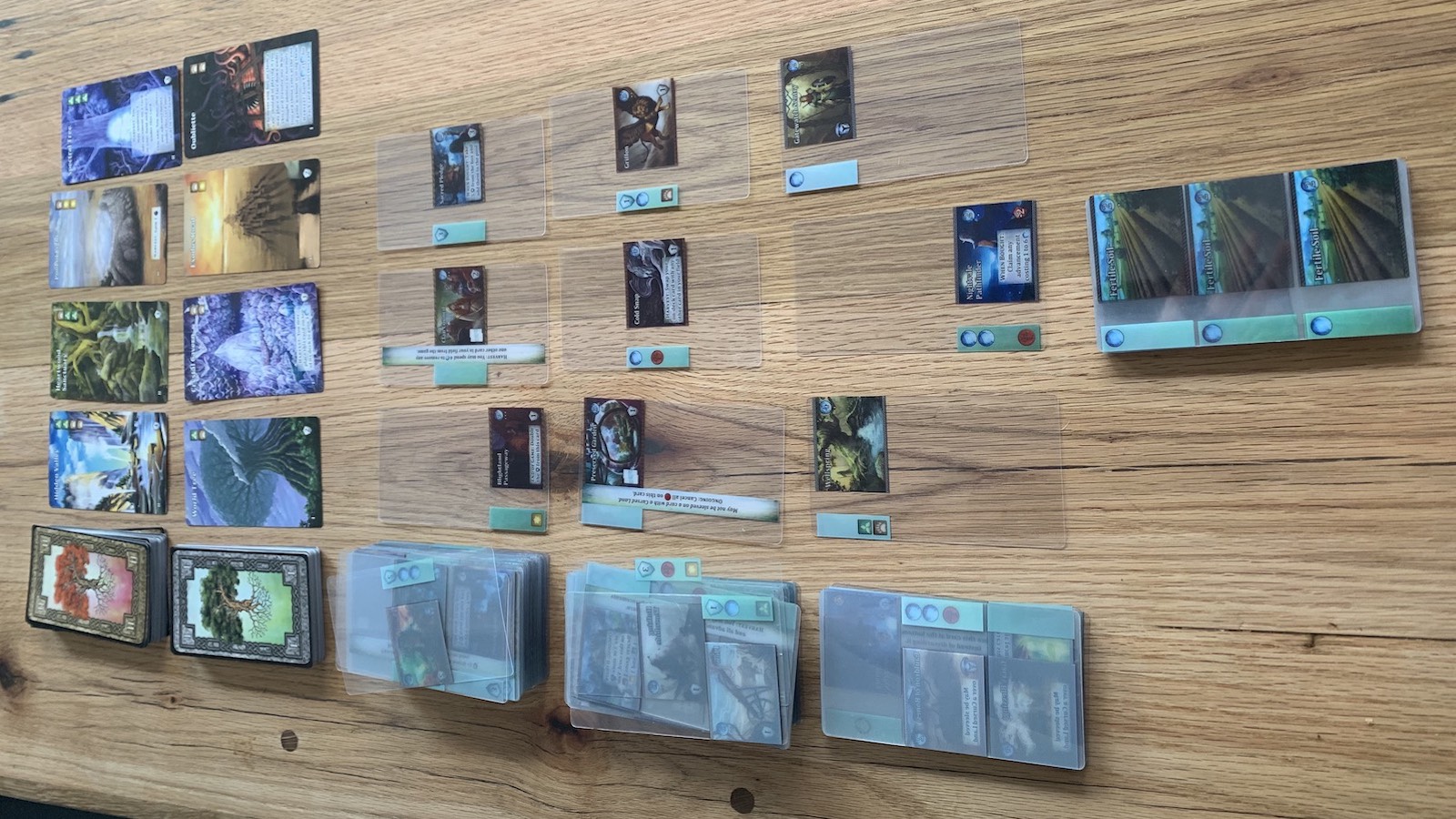
Players also deal out four more traditional cards from both of the Vale decks. The Vale cards are not made of the plastic material the Advancement cards are made from, but rather a more traditional paper with illustrations on the entire card. When a player, on their turn, has the means to purchase any of these cards they may. To do this, a player deals cards from their personal deck in a specific manner: A player flips the top card over, looks at the symbols on it, and places it in their field; repeating this until three red “Decay” symbols are visible; once this happens, the player leaves that card face up on top of the deck (called on-deck) and not in their field. If at any point the player has four Decay showing in their field AND on-deck, the player spoils and has to pick up all the cards in their field and discard them,immediately ending their turn. So when three Decay are showing, the player can choose to stop there and make their purchases, or push. Pushing involves putting that on-deck card into the field and turning over the next. As discussed, should that next card reveal a fourth Decay, the turn ends.
If choosing not to push, or with a push that doesn’t spoil, the player looks to the dealt-out cards in the Commons and chooses cards to purchase. Little grey-blue orbs on the sides of the cards represent Mana, and are the main currency of the game. An identical Mana orb with a number on it is on the top right corner of every Advancement card, which states the card’s cost. The total Mana in a player’s field is the player’s budget for purchasing cards on a given round. As long as they have the Mana to purchase it, they simply take any cards (a maximum of 2) from the Commons and add it to their deck. If the player were to push and spoil, their Mana token dealt to them at the beginning of the game is flipped over to the blue orb side signifying an additional Mana that can be used in future turns. After using this, you simply flip it back over to its inactive side.
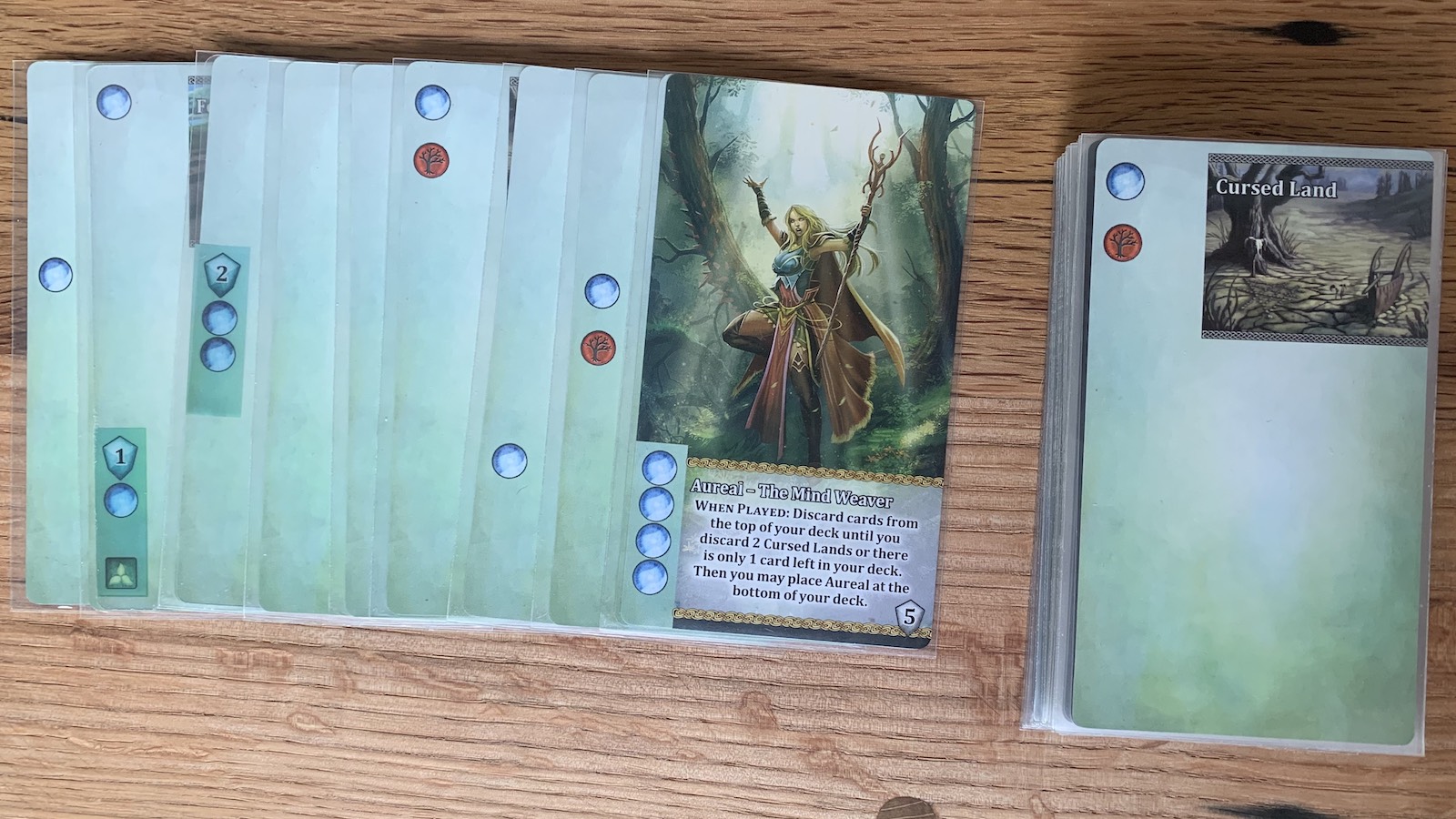
So far, typical deck builder, right? Well, the reason those Advancement cards are transparent, is that we aren’t building a deck. The player has 20 cards at the start of the game, and will have 20 cards at the end. The chosen Advancement is added to existing cards in the very field used to purchase it by slipping it into the sleeve of any of the cards present. This can only be done if the artwork on the Advancement doesn’t cover any current artwork present on the sleeved card. So if the desired Advancement has artwork in the top third of the card, and all of the cards in the player’s field have artwork in that area, the card cannot be purchased.
The Advancement of course has symbols of its own, making the card it was added to more powerful once all the cards have been drawn, and the deck gets reshuffled and turned back over. This is the main way this game is not a deck builder. The end result is similar, players make their decks more and more powerful for future turns, but the cards must be crafted well, as they will come up with the same frequency every time. Other symbols start to show up on the Advancements that make the game quicker and more interesting. Some symbols that look like small helmets are often only valuable if paired with other cards with the same symbol, growth symbols cancel out any Decay symbols in play, making your turn longer, and the Spirit symbols allow you to access the part of the Commons that holds the Vale Cards by acting as a currency to acquire them. Vale cards are not added to the deck, but rather set to the side. They sometimes give the player more Spirit symbols for future rounds, more Mana, or maybe only end game points, but they will never be shuffled or drawn. Their Advancements are present throughout every turn that they sit in front of the player. With enough Vale cards a player can really run away with the game.
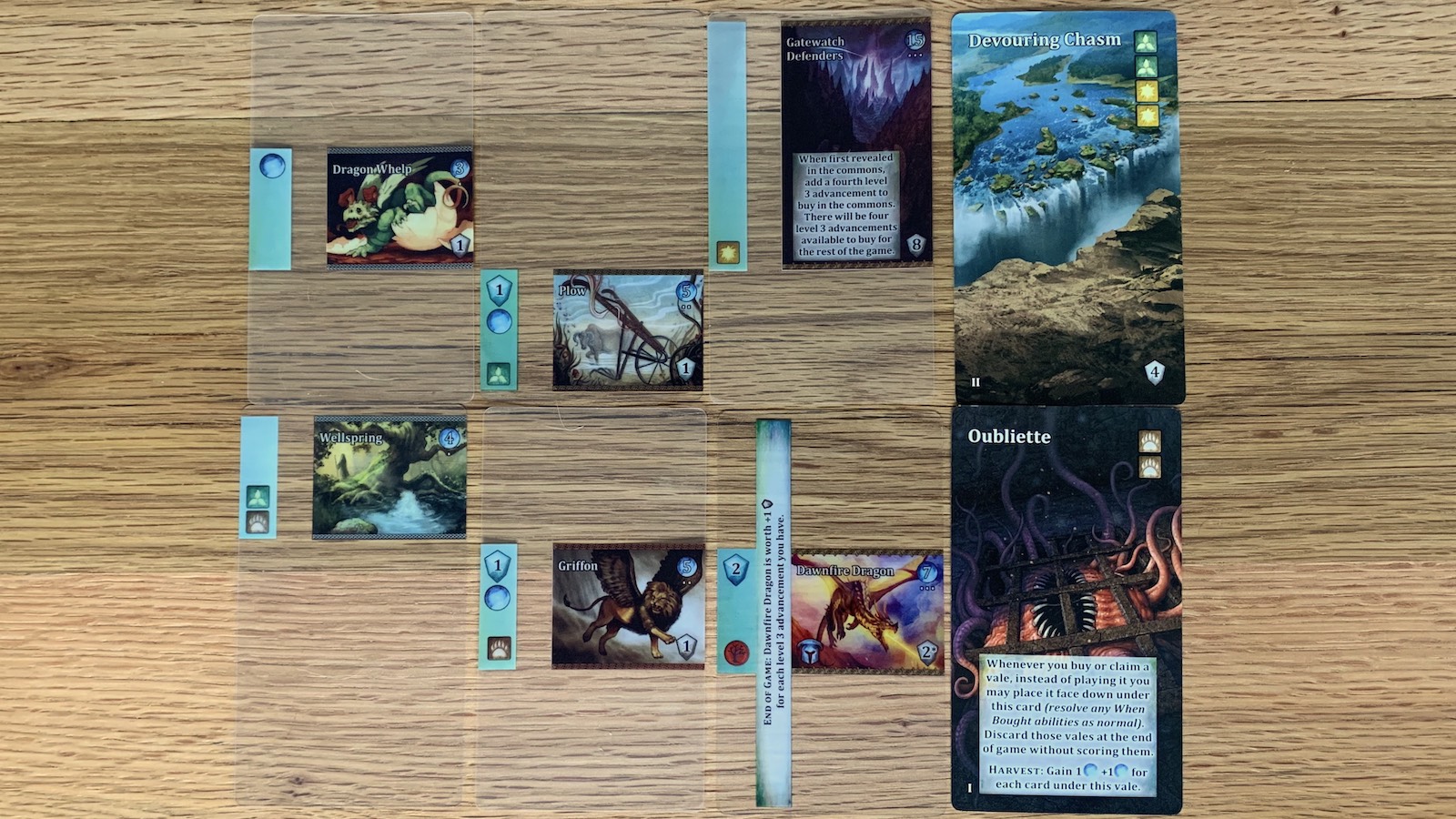
Lastly if a symbol looking exactly like the VP tokens shows up on the left side of the card, the player takes that many VP tokens from the pool. Other such symbols on the bottom right of the Advancement art, or Vale card award that many points to the player at the end of the game. Once the physical VP tokens are gone from the pool the game ends. Once this happens, all players count the VP tokens they’ve taken from their pool, and add to that total all end game VP on all purchased Advancement and Vale cards. The most VP wins the game.
That is Mystic Vale in a nutshell. Easy to learn and a great quick end-of-the-night kind of game when your group has one last game in them.
The Harmony Expansion is very much like the other expansions before it. It adds 105 Advancement cards, 36 Vale cards, and also a couple new additions not found in the base set.
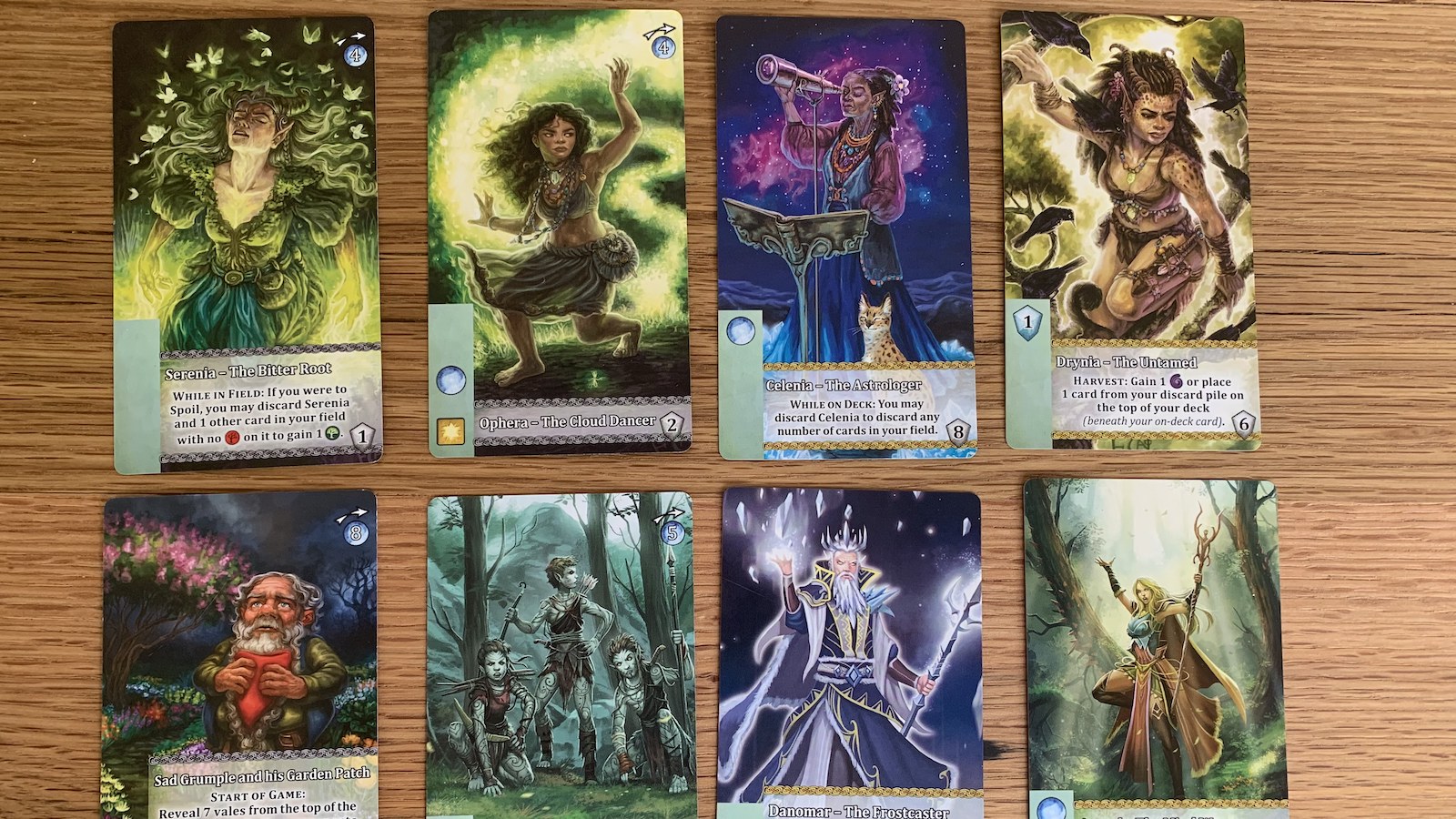
The first of these additions are Leader cards. Much like the Advancement cards, Leader cards have symbols on the side for when they are drawn on a players turn, but much like the Vale card, Leaders are printed on paper with top to bottom illustrations. Leader cards can not have Advancement cards added to them. Each player chooses one of these double-sided Leader cards before the game starts, and inserts it face up into a sleeve containing a blank card. The leaders have substantial powers on the starting side, but also a Mana symbol on the top right corner signifying how much it costs to flip the leader to its advanced side. Depending on the leader, sometimes this advanced side stays up for the remainder of the game, and sometimes once this power gets used the card is flipped back over. The player must use their Mana they would have instead used to purchase new Advancements to turn over the leader.
These leaders are very powerful and can completely change how the player plays their turn, often giving the player a lot more Mana, growth symbols, VP grabs, or other various powers. Some of the strongest leaders also give you negative endgame VP or an abnormal amount of Decay, so tread lightly. When the player pays Mana on their turn to flip the Leader card, it always makes that leader more powerful, and sometimes takes away those negative effects.
Also new to the game are the amulets which are also chosen by players before play starts. These replace the old Mana tokens, and work the same way. The amulets start on their used side, and are only flipped when a player spoils on their turn. The other “active” side gives the player asymmetrical powers for use in future turns instead of the across the board extra Mana the tokens of the base set offer. Like the leaders, the more powerful ones also carry deterrents such as negative points, but can offer Spirit symbols, Growth symbols, or special exceptions on the rules once for that player. Once used, the amulets are flipped over to their used side again.
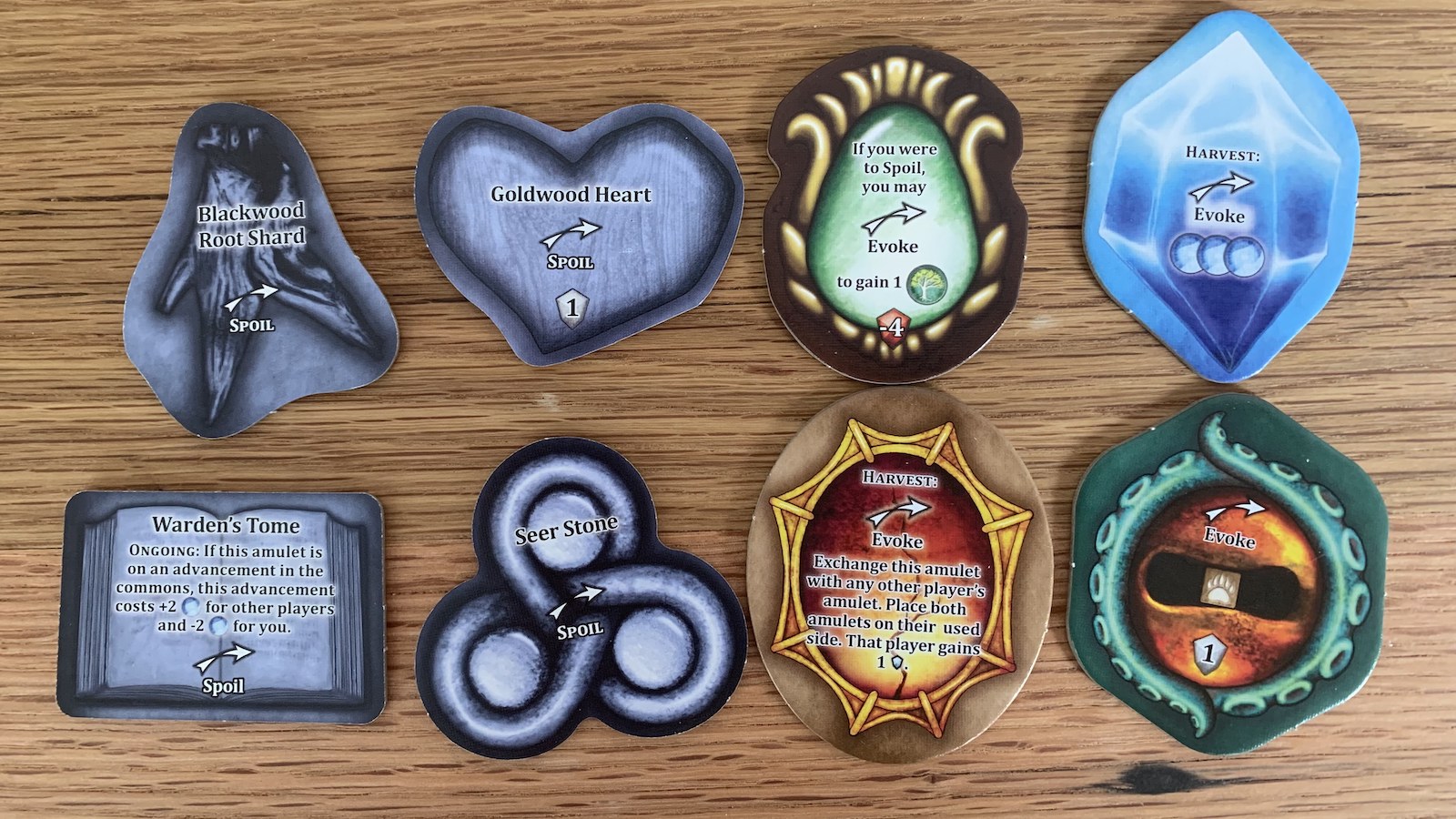
As I said, this type of expansion is not atypical for Mystic Vale. It’s not the first time Leaders or Amulets have been introduced, and otherwise it just adds more Vale and Advancement cards to make the play less predictable to a seasoned player. Having played other expansions before this one, it seems that each has a specific focus on how it changes gameplay. Another might introduce negative VP for the first time making play a lot more risky, but this one seems to want the play to continue a little longer than usual.
I noticed that this expansion deals with a lot more Spirit symbols, and a lot less VP tokens awarded from cards. The end result is a game that lasts longer, as the VP pool isn’t depleted nearly as quickly, and a lot more attention is paid to the Vale. The length is also increased by the fact that the player now has so many cards with so many powers to keep track of every turn. If a player doesn’t pay attention to every Vale card they possess, they could miss a huge buying opportunity.
This is one of the parts of the game I feel could be criticized. Once someone gets so powerful, it’s hard to keep track of all the buying power they have, and sometimes what they’ve already used. The player can purchase up to four cards per turn (two Advancements, and two Vale) and often have ample purchasing power stashed all over the place to do so. What you’ve spent, and what you have left to spend can get away from you, and sometimes you have to start the turn over to make sure you’ve done it right.
I love the idea of every expansion adding a different feel to the game, and eventually all evening each other out, but if you already like the length and complexity of the game, this one might not be for you. Personally, I loved it because my group got so used to this game that we often blazed through it – barely looking up or talking the whole time. This expansion made us slow down and really consider what we could do with our turns. There is a suggestion in the instruction book that says this expansion could be used as a “Base Game Replacement”. I would urge against that idea, the game would be too focused on the Vales, and take way too long.
The other con I hear complaints about with games like this is the element of “group solitaire”. It’s true that I’ve played the base set with my group who knows the game well, and maybe said little but “I’m pushing”, “I’ve spoiled”, or “damnit, I wanted that card”. You’ll end up taking things that others are saving for, but mostly without knowing it. You’re spending so much time trying to figure out how to best play your turn, that the turns of others will mostly not enter your view. I still love to play this game, but a social game it is absolutely not.
This, for a while, was one of my most played games on my shelf. It’s brief fast play that makes you think just enough, but not too much after you’ve played a couple of heavier games already that evening makes it a perfect addition for the shelf of someone that needs a lighter game. It does suffer the same complaint of any game with many expansions, and that is how to fit all these great cards into the original box.
Mystic Vale Harmony Expansion
Great
Harmony makes the elusive Vale cards in Mystic Vale much more accessible, and extends gameplay. This eventually makes the game much more complex which makes it more fun and thought provoking, but also harder to keep track of.
Pros
- Extended game play
- Extra powers from the Leaders, Amulets, and access to Vales
- More cards make replays more varied
Cons
- Can make each turn overly complicated
- Some may hate the lack of social connection
- Too much for one box when coupled with earlier expansions.
